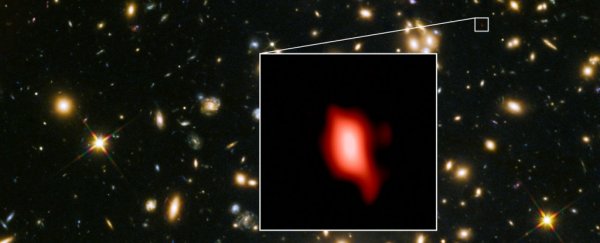Astronomers using some of the most powerful telescopes on Earth have found evidence that stars were forming incredibly early on in the life of the Universe - just 250 million years after the Big Bang, well before the proverbial dust had settled.
That's when the Universe was just 2 percent of its current age - and a finding that breaks the previous record for evidence of early star formation.
It also breaks the record for the oldest oxygen ever detected, at 13.28 billion light-years away (500 million years after the Big Bang) - the smoking gun for that early star formation.
The Universe's very early years are notoriously difficult to study. We have a rough idea about what was going on, but it's insanely far away and any radiation is difficult for our instrumentation to detect, particularly before the Universe was about 300 million years old.
After that, objects in the Universe become progressively easier to see, and it's one of these that was the focus of an international team of astronomers, led by Takuya Hashimoto, an astronomer at Osaka Sangyo University and the National Astronomical Observatory of Japan.
They trained the Atacama Large Millimetre/submillimetre Array (ALMA) in Chile on one of the farthest known objects in the Universe, a galaxy named MACS1149-JD1.
And although it was faint, the researchers detected the signal of oxygen in the galaxy's spectrum.
Based on the wavelength of the light, stretched from infrared to microwave by the expansion of the Universe, the team ascertained that the galaxy is 13.28 billion light-years away.
This finding was independently verified by detection of a neutral hydrogen emission from the galaxy made by the European Southern Observatory's Very Large Telescope.
"I was thrilled to see the signal of the distant oxygen in the ALMA data," Hashimoto said. "This detection pushes back the frontiers of the observable Universe."
Why is oxygen so significant? Because in the early Universe, there was none. It would take stars to create it; and not just their existence, but their deaths. Oxygen forms in stars, which then release it into the surrounding space when they die.
There, it becomes ionised from the radiation of other stars - glowing brightly in infrared. In order for oxygen to be producing infrared radiation in MACS1149-JD1, the galaxy would have to already have produced a generation of stars that lived and died.
"This galaxy is seen at a time when the Universe was only 500 million years old and yet it already has a population of mature stars," said one of the team, cosmologist Nicolas Laporte at University College London in the UK.
"We are therefore able to use this galaxy to probe into an earlier, completely uncharted period of cosmic history."
The next step was to determine how exactly the galaxy could have created the observed oxygen profile.
The team used infrared data from two space-based telescopes, the Hubble Space Telescope and the Spitzer Space Telescope. They found that the brightness of the galaxy would be very neatly explained by a model wherein the first stars formed 250 million years prior.
According to this model, that first burst of star formation blew the gas away from the galaxy, which would have suppressed star formation. But then the gas would have fallen back in, igniting a second burst of star formation at around the time of the ALMA observations, 500 million years after the Big Bang.
It's the massive newborn stars from this second burst of star formation that would have ionised the oxygen left over from the first generation.
This means that stars were forming earlier than we can see with our telescopes - but also that we are closer to finding what is known as the cosmic dawn, when the very first stars emerged.
"Determining when cosmic dawn occurred is akin to the 'Holy Grail' of cosmology and galaxy formation," said Richard Ellis, an astrophysicist at University College London and co-author on the paper.
"With MACS1149-JD1, we have managed to probe history beyond the limits of when we can actually detect galaxies with current facilities. There is renewed optimism we are getting closer and closer to witnessing directly the birth of starlight.
"Since we are all made of processed stellar material, this is really finding our own origins."
The research has been published in the journal Nature.
